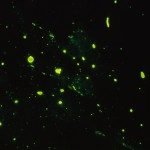Link to Pubmed [PMID] – 16051841
J. Virol. 2005 Aug;79(16):10487-97
European bat lyssaviruses types 1 and 2 (EBLV-1 and EBLV-2) are widespread in Europe, although little is known of their evolutionary history. We undertook a comprehensive sequence analysis to infer the selection pressures, rates of nucleotide substitution, age of genetic diversity, geographical origin, and population growth rates of EBLV-1. Our study encompassed data from 12 countries collected over a time span of 35 years and focused on the glycoprotein (G) and nucleoprotein (N) genes. We show that although the two subtypes of EBLV-1–EBLV-1a and EBLV-1b–have both grown at a low exponential rate since their introduction into Europe, they have differing population structures and dispersal patterns. Furthermore, there were strong constraints against amino acid change in both EBLV-1 and EBLV-2, as reflected in a low ratio of nonsynonymous to synonymous substitutions per site, particularly in EBLV-1b. Our inferred rate of nucleotide substitution in EBLV-1, approximately 5 x 10(-5) substitutions per site per year, was also one of the lowest recorded for RNA viruses and implied that the current genetic diversity in the virus arose 500 to 750 years ago. We propose that the slow evolution of EBLVs reflects their distinctive epidemiology in bats, where they occupy a relatively stable fitness peak.

